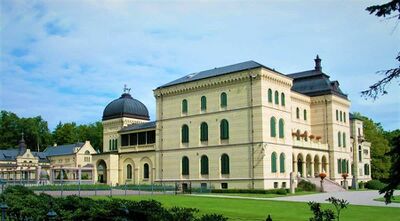Vedotī Imperial Palace
This article is incomplete because it is pending further input from participants, or it is a work-in-progress by one author. Please comment on this article's talk page to share your input, comments and questions. Note: To contribute to this article, you may need to seek help from the author(s) of this page. |
| Vedotī Imperial Palace | |
|---|---|
 The Vedotī Imperial Palace after having reparations done in 2013. | |
| Location | Vedotī, Flatstone |
| Built | 1236-1243 |
| Visitors | 89,500 (in 2018) |
| Governing body | Northern Ivili Clan |
| Website | www.vedotipalace.rock |
The Vedotī Imperial Palace is a historical site located in Vedotī, Flatstone. The palace began initial construction in 1236 just a year before the death of Bjarn Von Stone and just a year after the conclusion of the Second Stonish War of Unification. Since then, the palace has undergone several reoperations throughout the 20th century due to damages caused by negligent tourists and an overall lack of care by the republican government that ruled the nation throughout the 60's until the start of the 21st century.
History
Construction
Design
The imperial palace's design was intended to be conservatory, conservatory of the space available specifically. Because of this, the palace is relatively small in size, only being comprised of five separate buildings in total, each of which were two stories and of varying sizes. The first is the main building, intended to serve as the residency of the royal family, and thus the first building has four to five separate master bedrooms, up to three bathrooms, a dining room, and a sizeable kitchen. The main building also includes a number of storage closets and utility rooms, however these are not operated by the royal family. The second building was intended to serve as a dining hall for the use of any visitors, the staff, and even the royal family if the need were to arise. The third, fourth, and fifth buildings are not for the use of the royal family, but rather it's guards, staff, and whomever else it may need to service. These buildings are identical in design, shape, and size. They each have two bathrooms, one on each floor, that is shared collectively by all of the occupants of the floor. Each floor additionally has one storage closet/utility room that occupies the furthest corner from the entrance. The rest of the space on each floor is occupied by three different rooms, each of which have four beds, meaning that each building is capable of housing 24 occupants at one time.
Slave Labour
Throughout the seven years that it took to construct the imperial palace, a variety of methods were used to compensate for the lack of sufficient human labour. The most notable of these methods was slavery, a practice that has been universally frowned upon within the nation of Flatstone since it's creation in the 1230's. However, this was an exception, as completing the construction of the palace was deemed urgent by Eirik Von Stone, the King of Flatstone at the time of the palace's construction, and at the time there was an abundance of Taverkny and Ou soldiers that had been captured by the Northern Ivili army during the reunification wars. Eirik Von Stone finalized the decision to use slave labour to speed up the process of construction, enlisting upwards of three-hundred prisoners of war to participate in the palace's construction in 1238, two years into the palace's construction. The sacrifice of these men is honored with a memorial that was placed outside of the entrance of the imperial palace for all to see.
During Republican Rule
During the Stonish Civil War
The Museum was closed due to political unrest prior to the The Stonish Civil War in 2003, later being closed permanently in 2008 following the end of the civil war, the palace having been permanently returned to the royal family post-war. The palace itself wouldn't see full liberation by the royal family during the war, only being occupied following its conclusion when the city of Vedotī was surrendered to the royal family.